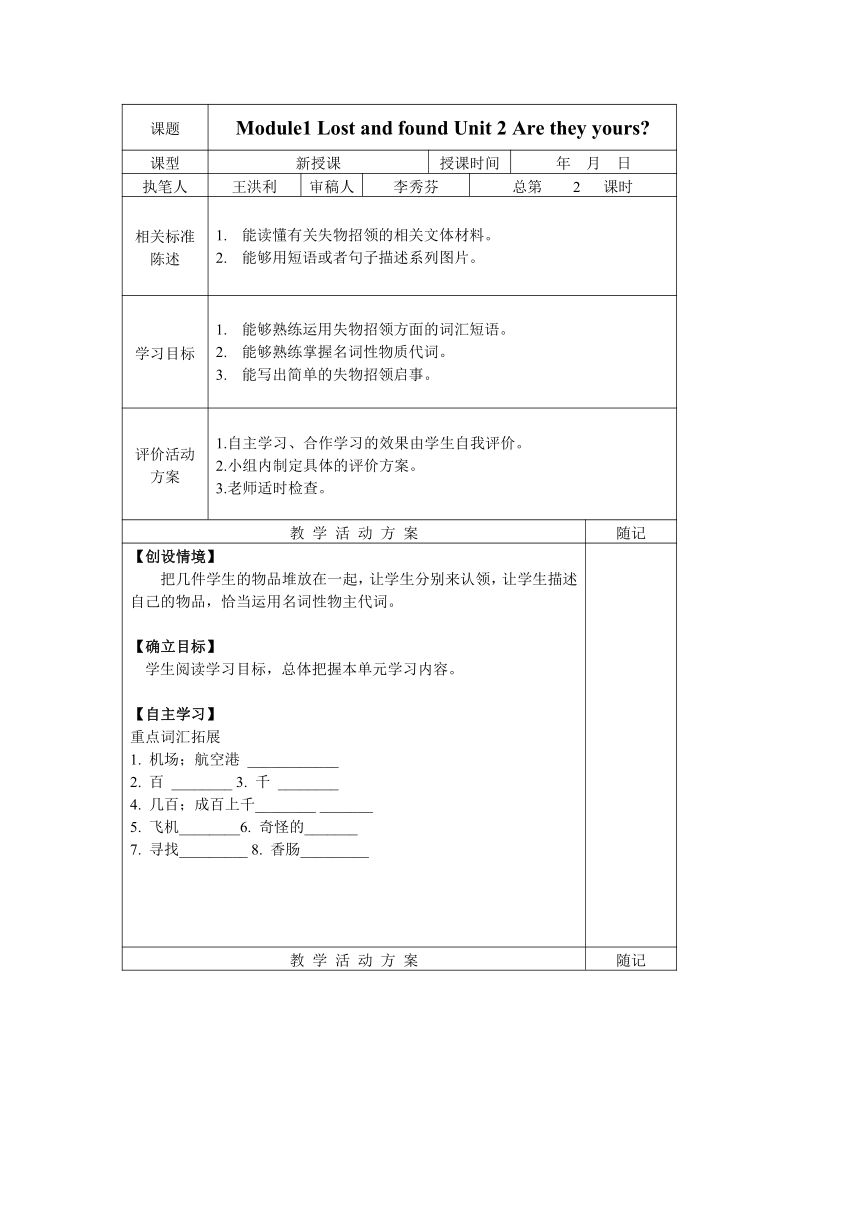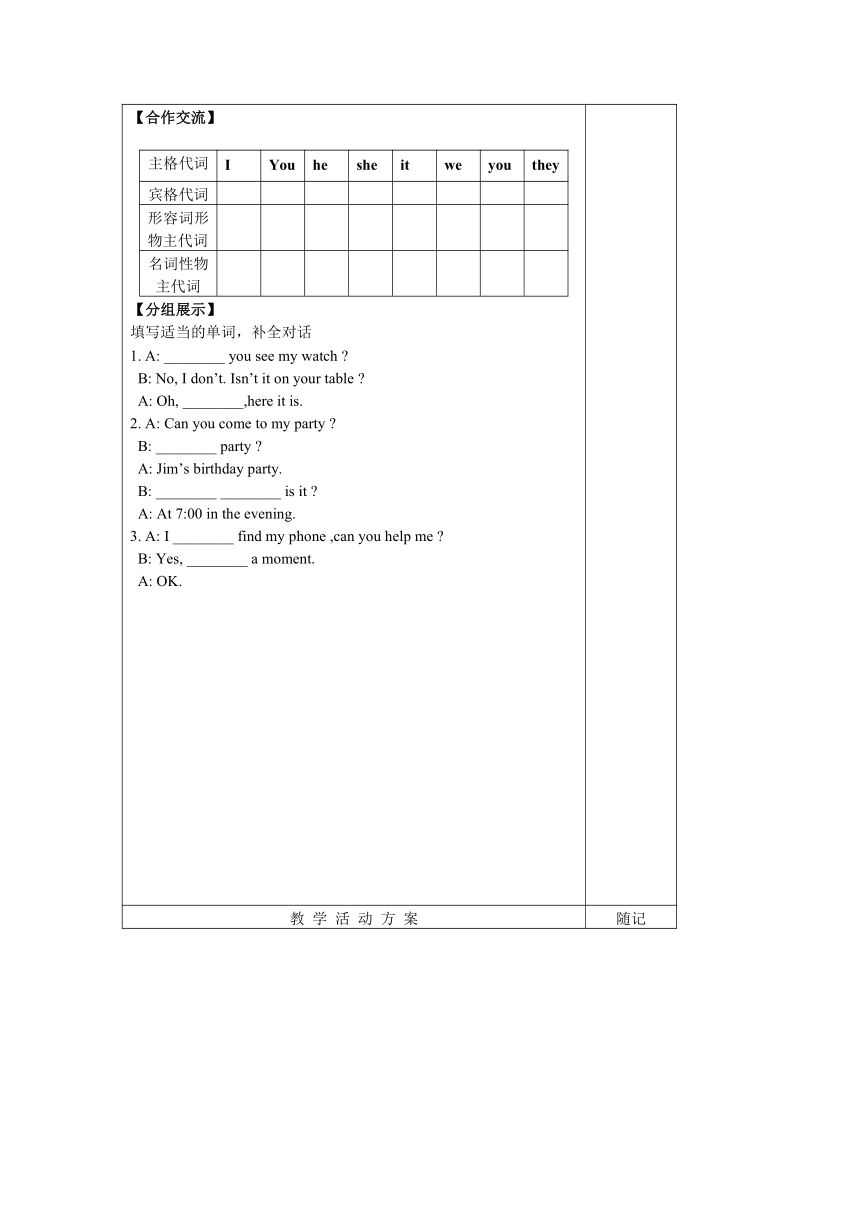学案m1 Lost and found>Unit 2 Are they yours?
文档属性
| 名称 | 学案m1 Lost and found>Unit 2 Are they yours? |  | |
| 格式 | zip | ||
| 文件大小 | 16.1KB | ||
| 资源类型 | 教案 | ||
| 版本资源 | 外研版 | ||
| 科目 | 英语 | ||
| 更新时间 | 2013-03-16 22:51:56 | ||
图片预览


文档简介
课题
Module1 Lost and found Unit 2 Are they yours?
课型
新授课
授课时间
年 月 日
执笔人
王洪利
审稿人
李秀芬
总第 2 课时
相关标准陈述
能读懂有关失物招领的相关文体材料。
能够用短语或者句子描述系列图片。
学习目标
能够熟练运用失物招领方面的词汇短语。
能够熟练掌握名词性物质代词。
能写出简单的失物招领启事。
评价活动
方案
1.自主学习、合作学习的效果由学生自我评价。
2.小组内制定具体的评价方案。
3.老师适时检查。
教 学 活 动 方 案
随记
【创设情境】
把几件学生的物品堆放在一起,让学生分别来认领,让学生描述自己的物品,恰当运用名词性物主代词。
【确立目标】
学生阅读学习目标,总体把握本单元学习内容。
【自主学习】
重点词汇拓展
1. 机场;航空港 ____________
2. 百 ________ 3. 千 ________
4. 几百;成百上千________ _______
5. 飞机________6. 奇怪的_______
7. 寻找_________ 8. 香肠_________
教 学 活 动 方 案
随记
【合作交流】
主格代词
I
You
he
she
it
we
you
they
宾格代词
形容词形物主代词
名词性物主代词
【分组展示】
填写适当的单词,补全对话
1. A: ________ you see my watch ?
B: No, I don’t. Isn’t it on your table ?
A: Oh, ________,here it is.
2. A: Can you come to my party ?
B: ________ party ?
A: Jim’s birthday party.
B: ________ ________ is it ?
A: At 7:00 in the evening.
3. A: I ________ find my phone ,can you help me ?
B: Yes, ________ a moment.
A: OK.
教 学 活 动 方 案
随记
【解疑释惑】
talk to…意为“和… …交谈”,talk作不及物动词,意为“讨论;交谈”。talk about sth.讨论某事 talk with sb. 和某人交谈
get on 上车 get off 下车get on well with sb. 与某人相处融洽 get on well with sth. 某事进展顺利
I’m getting on well with my classmetes.我和我的同学相处的很融洽。How are you getting on well with your work?你的工作进展如何?
in a hurry 意为“匆匆忙忙地”hurry to do sth. 匆忙做某事
leave sth. + 地点,表示把某物落在某地
I often leave my homework at home.我经常把作业忘在家里。
That’s why …意为“是… …的原因”That’s why they are on the news.那就是新闻报道他们的原因。
hundreds of 意为“数百”,类似的短语还有thousands of(数以千计的),millions of (数百万的)。
注意:hundreds of表示的是一个概数,前面不能再加基数词修饰。当hundred表示确切数目时,其前有一个具体的基数词修饰,此时hundred既不变为复数,也不与of连用
【巩固训练】
用所给词的正确形式填空
1. Mike often ________(play) football.
2. ________ you ________(like) Chinese food or Western food?
3. My English________(teach) is an old American.
4. —I feel very bored.
—What about ________(see) a film at the cinema?
5. Jerry ________(not do) his homework at noon
6. There ________(be) a pen and two boos on the desk.
教 学 活 动 方 案
随记
【拓展提升】
阅读理解
Sydney is the largest city in Australia. People call it “New York in the Southern Hemisphere(南半球)”.
People in Sydney call themselves Sydneysiders(悉尼人,悉尼居民). More than thirty thousand native(本土的) people in Australia live in Sydney and people call them aborigines(原居民). In the late 1700s,most of the people in Sydney were British.
The city has many famous places. The Sydney Opera House is one of the most famous buildings in the world. It has about 1,000 rooms. The Sydney Tower is another place to visit. It is 304.8 meters high. On the tower,people can see the whole city of Sydney.
Because Sydney is in the Southern Hemisphere,its season is opposite to (相反的) that in the Northern Hemisphere. The coldest month of the year in Sydney is July. People here seldom(很少) see snow,but it snows sometimes.
1. Sydney is ________ in Australia.
A. the biggest city B. the second largest city
C. the smallest city D. the second smallest city
2. We call the native people in Australia ________.
A. Sydneysiders B. aborigines C. Australians D. British
3. In the late 1700s,most of the people in Sydney were ________.
A. New Yorks B. Americans C. British D. native people
4. Which of the following sentences is not RIGHT?
A. Sydney is in the Northern Hemisphere.
B. The Sydney Opera House has about 1,000 rooms.
C. On the Sydney Tower,people can see the whole Sydney.
D. Sydney is a good place to visit.
5. When it is summer in China,it is ________ in Sydney.
A. winter B. autumn C. summer D. spring
【作业布置】
根据提示写寻物启事和招领启事
1. Lost: Mr.Wang 丢了一个黑色钱包,他的电话是13963518238。
2. Found:Helen Green 拾到了一个手机,她的电话是5740107。
Module1 Lost and found Unit 2 Are they yours?
课型
新授课
授课时间
年 月 日
执笔人
王洪利
审稿人
李秀芬
总第 2 课时
相关标准陈述
能读懂有关失物招领的相关文体材料。
能够用短语或者句子描述系列图片。
学习目标
能够熟练运用失物招领方面的词汇短语。
能够熟练掌握名词性物质代词。
能写出简单的失物招领启事。
评价活动
方案
1.自主学习、合作学习的效果由学生自我评价。
2.小组内制定具体的评价方案。
3.老师适时检查。
教 学 活 动 方 案
随记
【创设情境】
把几件学生的物品堆放在一起,让学生分别来认领,让学生描述自己的物品,恰当运用名词性物主代词。
【确立目标】
学生阅读学习目标,总体把握本单元学习内容。
【自主学习】
重点词汇拓展
1. 机场;航空港 ____________
2. 百 ________ 3. 千 ________
4. 几百;成百上千________ _______
5. 飞机________6. 奇怪的_______
7. 寻找_________ 8. 香肠_________
教 学 活 动 方 案
随记
【合作交流】
主格代词
I
You
he
she
it
we
you
they
宾格代词
形容词形物主代词
名词性物主代词
【分组展示】
填写适当的单词,补全对话
1. A: ________ you see my watch ?
B: No, I don’t. Isn’t it on your table ?
A: Oh, ________,here it is.
2. A: Can you come to my party ?
B: ________ party ?
A: Jim’s birthday party.
B: ________ ________ is it ?
A: At 7:00 in the evening.
3. A: I ________ find my phone ,can you help me ?
B: Yes, ________ a moment.
A: OK.
教 学 活 动 方 案
随记
【解疑释惑】
talk to…意为“和… …交谈”,talk作不及物动词,意为“讨论;交谈”。talk about sth.讨论某事 talk with sb. 和某人交谈
get on 上车 get off 下车get on well with sb. 与某人相处融洽 get on well with sth. 某事进展顺利
I’m getting on well with my classmetes.我和我的同学相处的很融洽。How are you getting on well with your work?你的工作进展如何?
in a hurry 意为“匆匆忙忙地”hurry to do sth. 匆忙做某事
leave sth. + 地点,表示把某物落在某地
I often leave my homework at home.我经常把作业忘在家里。
That’s why …意为“是… …的原因”That’s why they are on the news.那就是新闻报道他们的原因。
hundreds of 意为“数百”,类似的短语还有thousands of(数以千计的),millions of (数百万的)。
注意:hundreds of表示的是一个概数,前面不能再加基数词修饰。当hundred表示确切数目时,其前有一个具体的基数词修饰,此时hundred既不变为复数,也不与of连用
【巩固训练】
用所给词的正确形式填空
1. Mike often ________(play) football.
2. ________ you ________(like) Chinese food or Western food?
3. My English________(teach) is an old American.
4. —I feel very bored.
—What about ________(see) a film at the cinema?
5. Jerry ________(not do) his homework at noon
6. There ________(be) a pen and two boos on the desk.
教 学 活 动 方 案
随记
【拓展提升】
阅读理解
Sydney is the largest city in Australia. People call it “New York in the Southern Hemisphere(南半球)”.
People in Sydney call themselves Sydneysiders(悉尼人,悉尼居民). More than thirty thousand native(本土的) people in Australia live in Sydney and people call them aborigines(原居民). In the late 1700s,most of the people in Sydney were British.
The city has many famous places. The Sydney Opera House is one of the most famous buildings in the world. It has about 1,000 rooms. The Sydney Tower is another place to visit. It is 304.8 meters high. On the tower,people can see the whole city of Sydney.
Because Sydney is in the Southern Hemisphere,its season is opposite to (相反的) that in the Northern Hemisphere. The coldest month of the year in Sydney is July. People here seldom(很少) see snow,but it snows sometimes.
1. Sydney is ________ in Australia.
A. the biggest city B. the second largest city
C. the smallest city D. the second smallest city
2. We call the native people in Australia ________.
A. Sydneysiders B. aborigines C. Australians D. British
3. In the late 1700s,most of the people in Sydney were ________.
A. New Yorks B. Americans C. British D. native people
4. Which of the following sentences is not RIGHT?
A. Sydney is in the Northern Hemisphere.
B. The Sydney Opera House has about 1,000 rooms.
C. On the Sydney Tower,people can see the whole Sydney.
D. Sydney is a good place to visit.
5. When it is summer in China,it is ________ in Sydney.
A. winter B. autumn C. summer D. spring
【作业布置】
根据提示写寻物启事和招领启事
1. Lost: Mr.Wang 丢了一个黑色钱包,他的电话是13963518238。
2. Found:Helen Green 拾到了一个手机,她的电话是5740107。
同课章节目录
- Module 1 Lost and found
- Unit 1 Whose bag is this?
- Unit 2 Are they yours?
- Unit 3 Language in use
- Module 2 What can you do ?
- Unit 1 I can play the piano
- Unit 2 I can run really fast
- Unit 3 Language in use
- Module 3 Making plans
- Unit 1 What are you going to do at the weekends?
- Unit 2 We're going to cheer the players.
- Unit 3 Language in use
- Module 4 Life in the future
- Unit 1 Everyone will study at home
- Unit 2 Every family will have a small plane.
- Unit 3 Language in use
- Module 5 Shopping
- Unit 1 What can I do for you?
- Unit 2 You can buy everything on the Internet
- Unit 3 Language in use
- Module 6 Around town
- Unit 1 Could you tell me how to get to the Nationa
- Unit 2 The London Eye is on your right.
- Unit 3 Language in use
- Revision module A
- Module 7 My past life
- Unit 1 I was born in a small village.
- Unit 2 I was born in Quincy.
- Unit 3 Language in use
- Module 8 Story time
- Unit 1 Once upon a time….
- Unit 2 Goldilocks hurried out of the house.
- Unit 3 Language in use
- Module 9 Life history
- Unit 1 He left school and began work at the age of
- Unit 2 He decided to be an actor.
- Unit 3 Language in use
- Module 10 A holiday journey
- Unit 1 What did you do?
- Unit 2 This morning we took a walk.
- Unit 3 Language in use
- Module 11 Body language
- Unit 1 They touch noses!
- Unit 2 Here are some ways to welcome them.
- Unit 3 Language in use
- Module 12 Western music
- Unit 1 It's so beautiful!
- Unit 2 Vienna is the centre of European classical
- Unit 3 Language in use
- Revision module B
